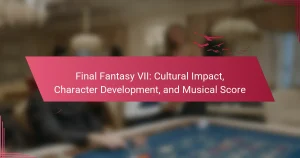Ni no Kuni captivates players with its rich storytelling and stunning visuals inspired by Studio Ghibli. The game emphasizes character development and emotional depth, reflecting Ghibli’s narrative techniques. Its vibrant aesthetics enhance the immersive experience, while music adds emotional resonance. Additionally, player choices shape the narrative, creating a unique blend of gaming and cinematic artistry.
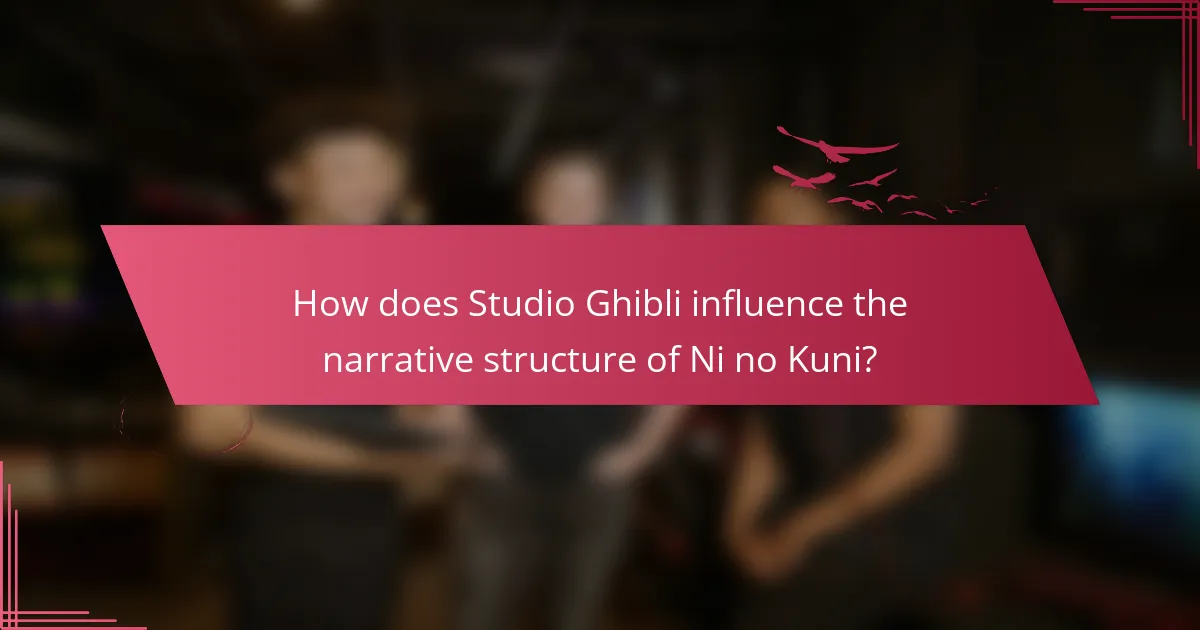
How does Studio Ghibli influence the narrative structure of Ni no Kuni?
Studio Ghibli significantly influences the narrative structure of Ni no Kuni through its emphasis on character development, emotional depth, and whimsical storytelling. The game mirrors Ghibli’s signature style by blending fantasy with relatable themes, creating a rich, immersive experience.
Key elements include the exploration of loss and growth, which are central to both Ghibli films and Ni no Kuni’s plot. Characters undergo transformative journeys, reflecting the studio’s focus on personal evolution. Additionally, the visual aesthetics of Ni no Kuni, inspired by Ghibli’s animation, enhance storytelling by delivering a vibrant, enchanting world that captivates players.
The integration of music and sound design further enriches the narrative, echoing Ghibli’s approach to creating atmospheric storytelling. Overall, the influence of Studio Ghibli is evident in how Ni no Kuni crafts its narrative, making it a unique blend of gaming and cinematic artistry.
What storytelling techniques are uniquely employed in Ni no Kuni?
Ni no Kuni employs storytelling techniques that blend whimsical narratives with emotional depth. The integration of Studio Ghibli’s artistic style enhances character development and world-building. Unique attributes include the use of dual worlds, where the protagonist navigates both reality and a magical realm, creating a rich narrative tapestry. Rarely, the game incorporates environmental storytelling, allowing players to uncover lore through exploration and interaction. These techniques collectively engage players and evoke a strong emotional response.
Which character archetypes reflect Studio Ghibli’s influence in the game?
Ni no Kuni features character archetypes influenced by Studio Ghibli’s storytelling techniques. Key archetypes include the whimsical mentor, the brave young hero, and the compassionate sidekick. These characters embody growth, friendship, and adventure, reflecting Ghibli’s unique narrative style. The mentor archetype, often wise and magical, guides the hero through challenges. The hero typically faces personal growth through trials, while the sidekick provides emotional support and comic relief. This blend of archetypes enhances the game’s emotional depth and immersive experience.

What visual aesthetics define the world of Ni no Kuni?
Ni no Kuni’s visual aesthetics are defined by vibrant colors, whimsical character designs, and detailed environments. The Studio Ghibli influence is evident in its art style, which emphasizes hand-drawn elements and enchanting landscapes. This aesthetic approach enhances the storytelling, creating an immersive experience that captivates players. The blend of fantasy and realism in character animations adds depth, making the world feel alive and engaging.
How does the art style compare to classic Studio Ghibli films?
Ni no Kuni’s art style draws heavily from classic Studio Ghibli films, featuring lush landscapes and whimsical character designs. Both share a distinct hand-drawn aesthetic that emphasizes emotional storytelling. Ni no Kuni incorporates vibrant colors and detailed backgrounds, reminiscent of Ghibli’s enchanting worlds. The influence is evident in character expressions, which convey depth and personality, similar to iconic Ghibli characters. Overall, Ni no Kuni pays homage to Ghibli’s visual storytelling while establishing its unique charm.
What role does color play in the emotional storytelling of Ni no Kuni?
Color plays a significant role in the emotional storytelling of Ni no Kuni by evoking specific feelings and enhancing narrative depth. The game utilizes a vibrant color palette, influenced by Studio Ghibli, to convey mood and atmosphere. For instance, warm colors often reflect joy and adventure, while cool tones can signify sadness or danger. This strategic use of color helps players connect emotionally with characters and the unfolding story. Additionally, color transitions throughout the game mirror character development and thematic shifts, enriching the overall experience.
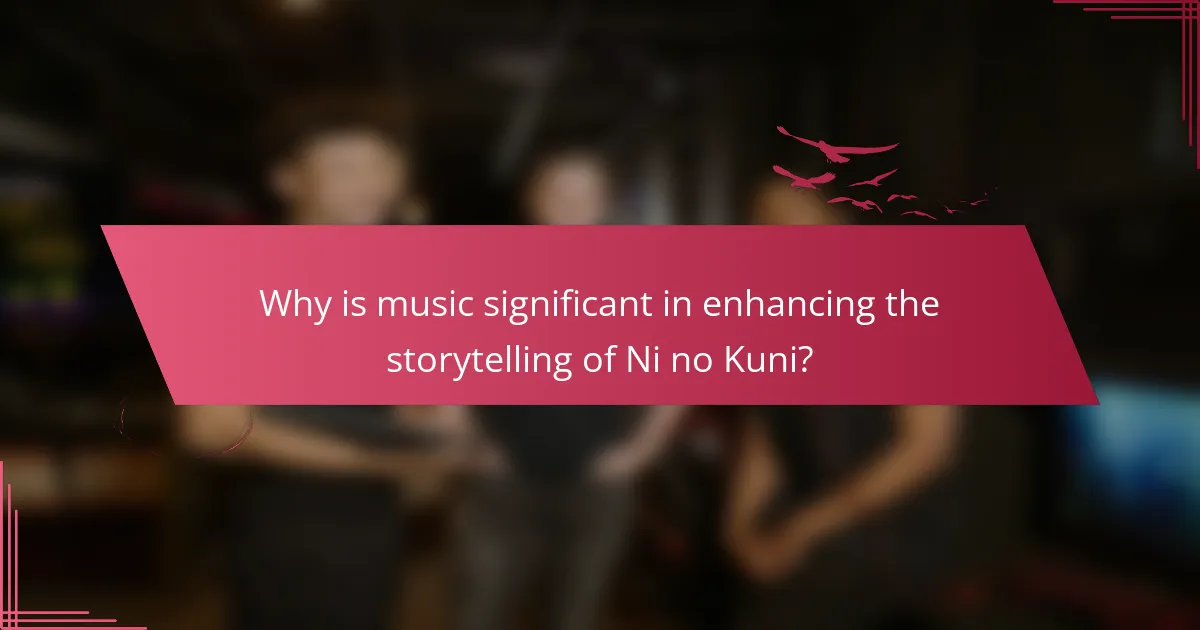
Why is music significant in enhancing the storytelling of Ni no Kuni?
Music significantly enhances storytelling in Ni no Kuni by creating emotional depth and atmosphere. The score, influenced by Studio Ghibli, complements the narrative, drawing players into the world. Themes of hope and adventure resonate, reinforcing character development and plot progression. The orchestral arrangements elevate key moments, making them memorable and impactful. As a result, music becomes a vital element, enriching the overall gaming experience and connecting players with the story.
Which composers contributed to the game’s soundtrack?
The soundtrack of “Ni no Kuni” features contributions from renowned composers Joe Hisaishi and Masashi Hamauzu. Joe Hisaishi, famous for his work with Studio Ghibli, created a rich orchestral score that enhances the game’s emotional depth. Masashi Hamauzu added unique compositions that blend traditional and contemporary styles, further enriching the game’s auditory experience.
How does the music reflect the game’s themes and atmosphere?
The music in Ni no Kuni enhances the game’s themes and atmosphere by evoking emotions and complementing the narrative. Composed by Joe Hisaishi, the score reflects Studio Ghibli’s signature style, merging orchestral elements with whimsical melodies. This musical backdrop deepens the player’s connection to the story, reinforcing moments of joy, sorrow, and adventure. The use of recurring motifs aligns with character development, making the soundtrack integral to the overall experience. Each track is crafted to resonate with specific scenes, creating a cohesive emotional journey throughout the game.
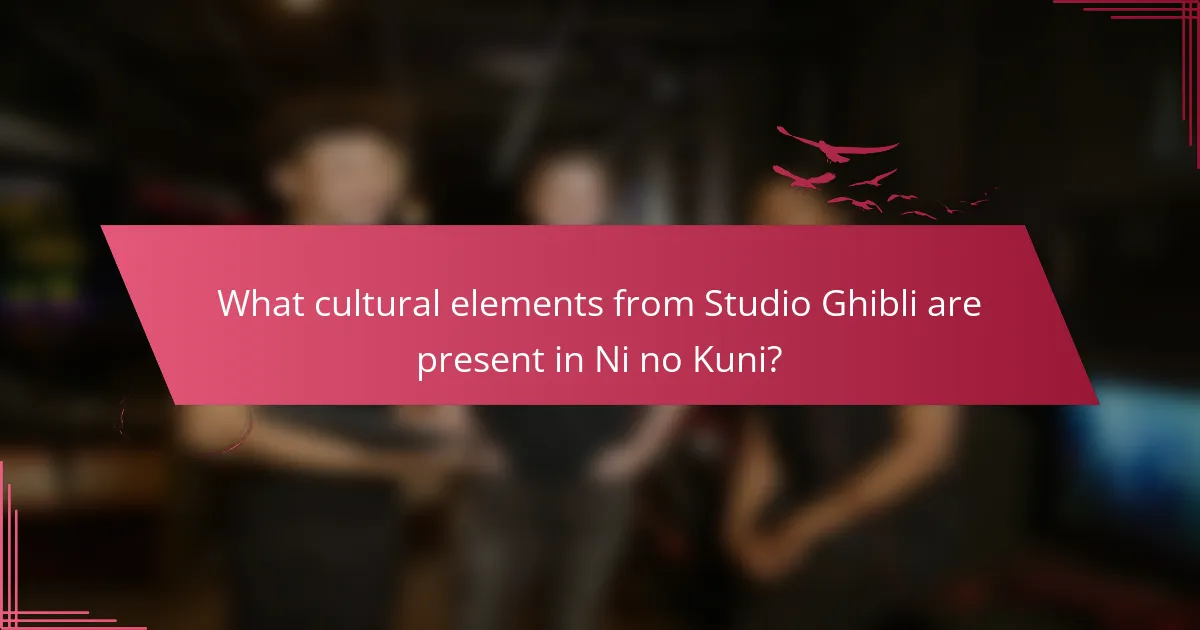
What cultural elements from Studio Ghibli are present in Ni no Kuni?
Ni no Kuni incorporates several cultural elements from Studio Ghibli, emphasizing storytelling techniques and visual aesthetics. The game reflects Ghibli’s signature art style, characterized by vibrant landscapes and detailed character designs. Additionally, it employs themes of nature, friendship, and the journey of self-discovery, mirroring Ghibli’s narratives. The whimsical yet profound storytelling resonates with Ghibli’s approach, blending fantasy and emotional depth. Unique attributes include the collaboration with Ghibli artists, enhancing the game’s visual storytelling.
How are themes of nature and environment depicted in the game?
Themes of nature and environment in “Ni no Kuni” are depicted through vibrant visuals and storytelling. The game showcases lush landscapes, magical creatures, and intricate ecosystems, reflecting Studio Ghibli’s artistic influence. Nature is portrayed as a living entity, integral to the narrative and character development. Environmental themes emphasize harmony and balance, highlighting the impact of human actions on the world. This connection fosters a sense of wonder and responsibility in players, enhancing the overall immersive experience.
Which folklore influences can be identified in the characters and settings?
Folklore influences in “Ni no Kuni” are evident in its characters and settings, drawing from various cultural myths. The game features familiar archetypes like the hero’s journey, reminiscent of classic folklore narratives. Settings reflect enchanted landscapes often found in fairy tales, enhancing the magical atmosphere. Unique creature designs are inspired by folkloric beings, showcasing a blend of wonder and whimsy. Additionally, moral lessons embedded in the storyline echo traditional folklore themes, emphasizing growth and adventure.
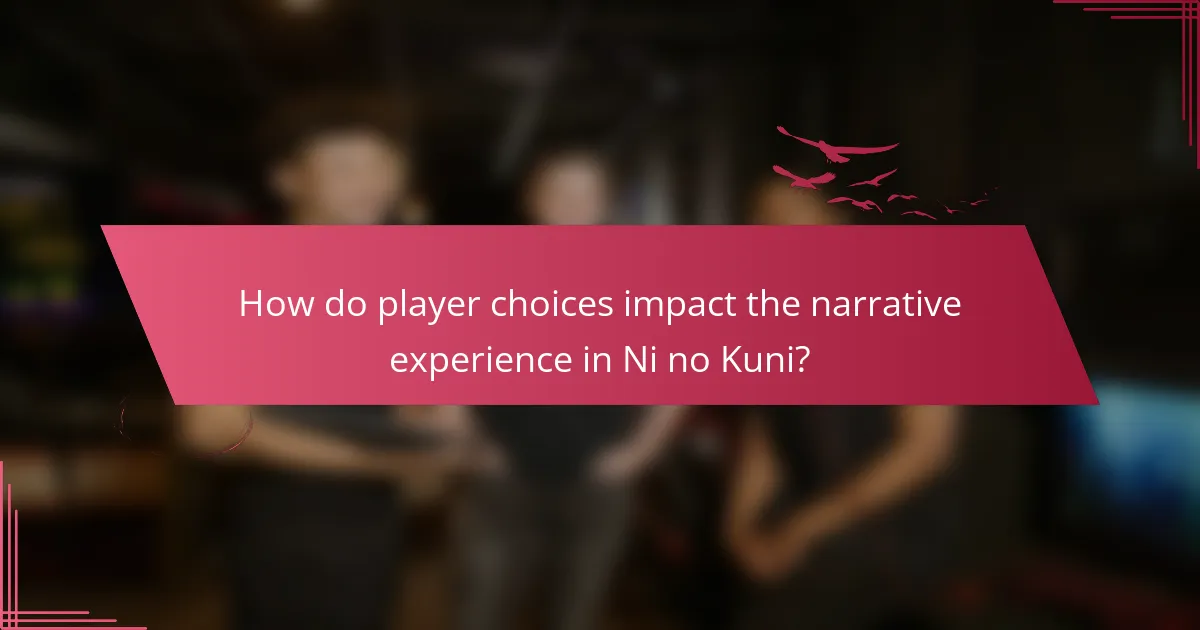
How do player choices impact the narrative experience in Ni no Kuni?
Player choices significantly shape the narrative experience in Ni no Kuni, influencing character development and story outcomes. The game employs a branching narrative structure, allowing decisions to alter relationships and plot directions. This interactivity enhances player engagement, making each choice impactful. The Studio Ghibli aesthetic complements this by creating an immersive world that reflects the consequences of player actions, enriching the overall storytelling experience. Emotional connections with characters deepen as players navigate moral dilemmas, reinforcing the significance of their choices.
What are the consequences of different decision paths in the game?
Different decision paths in “Ni no Kuni” lead to varied consequences, influencing character development, story progression, and player experience. Choices can affect relationships with characters, alter the narrative arc, and determine the game’s ending. For example, selecting to save a character may unlock unique abilities or quests. The visual aesthetics and storytelling techniques enhance these outcomes, making each decision impactful. These elements reflect Studio Ghibli’s influence, emphasizing emotional depth and immersive storytelling.
How does this interactive storytelling compare to traditional Ghibli narratives?
Interactive storytelling in “Ni no Kuni” offers a dynamic experience that contrasts with traditional Ghibli narratives. Ghibli films often rely on linear storytelling and rich character development, while “Ni no Kuni” incorporates player choices and exploration, enhancing engagement. This interactivity allows for personalized experiences, a unique attribute not present in Ghibli’s fixed narratives. Additionally, both share a visual aesthetic characterized by vibrant animation and whimsical worlds, yet “Ni no Kuni” integrates gameplay mechanics that alter the narrative flow, creating a rare blend of gaming and storytelling.
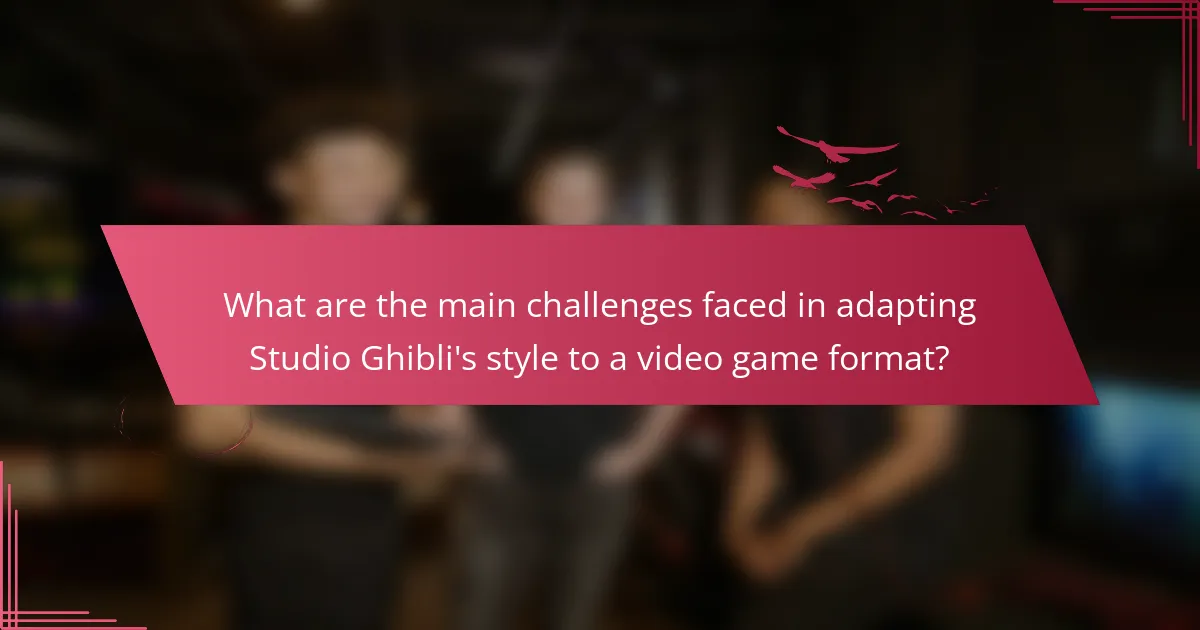
What are the main challenges faced in adapting Studio Ghibli’s style to a video game format?
Adapting Studio Ghibli’s style to a video game format presents significant challenges. The primary issues include capturing the essence of Ghibli’s storytelling, translating its unique visual aesthetics, and maintaining emotional depth in gameplay.
First, Ghibli’s narratives often feature intricate character development and themes of nature, which can be difficult to convey interactively. Ensuring players connect emotionally with characters requires innovative storytelling techniques that differ from traditional gaming narratives.
Second, Ghibli’s distinctive art style, characterized by hand-drawn animation and vibrant landscapes, poses technical challenges in a 3D gaming environment. Achieving a similar visual appeal while ensuring smooth gameplay demands advanced graphics technology and artistic direction.
Finally, balancing gameplay mechanics with narrative immersion is crucial. Players must feel engaged in the story while enjoying gameplay, a balance that can be hard to strike when adapting such a rich cinematic style.
Which limitations did developers encounter during production?
Developers faced several limitations during the production of “Ni no Kuni,” primarily related to technology and collaboration. The integration of Studio Ghibli’s animation style required advanced techniques that were challenging to implement. Additionally, the need for seamless storytelling demanded extensive coordination between teams, which sometimes led to miscommunication and delays. Resource constraints limited the scope of certain visual elements, impacting the overall artistic vision. Lastly, balancing gameplay mechanics with narrative depth posed creative challenges that required iterative adjustments.
How did they overcome these challenges to maintain the Ghibli essence?
Ni no Kuni maintained the Ghibli essence by integrating storytelling techniques and visual aesthetics characteristic of the studio. The collaboration with Studio Ghibli ensured authentic art direction, creating a whimsical world. The narrative structure mirrors Ghibli’s focus on character development and emotional depth, enhancing player engagement. Unique attributes, such as hand-drawn animations and a rich musical score, further reinforced the Ghibli influence, creating an immersive experience.
What lessons can be learned from the adaptation process of Ni no Kuni?
The adaptation process of Ni no Kuni teaches valuable lessons about blending storytelling and visual artistry. It highlights the importance of maintaining narrative integrity while incorporating unique visual aesthetics. Studio Ghibli’s influence emphasizes the emotional depth in character development, showcasing how animation can enhance storytelling. Additionally, the adaptation demonstrates the significance of cultural elements, making the narrative relatable to a broader audience. Balancing artistic vision with audience expectations is crucial for successful adaptations.
What best practices can be applied to future projects inspired by Studio Ghibli?
To apply best practices in future projects inspired by Studio Ghibli, focus on narrative depth, character development, and visual storytelling. Emphasize emotional resonance and immersive world-building. Incorporate hand-drawn aesthetics to enhance authenticity. Prioritize thematic exploration, such as nature and human connection, to align with Ghibli’s core values. Engage audiences through relatable characters and rich, layered plots.


